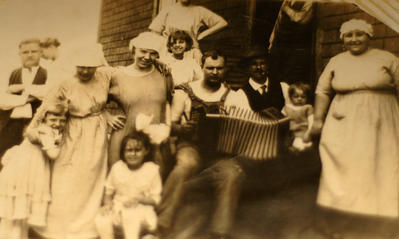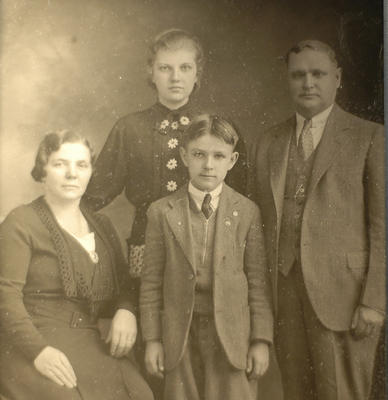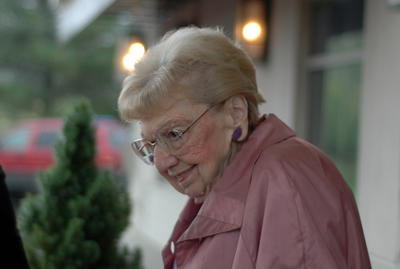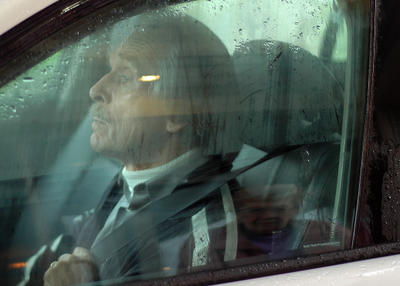
The anonymous photographer has presumably issued his instructions. Stand there. Smile. Hold still. You, move in a little closer. That's right. It is a group photo, a record of a festive day, a party of some sorts. The album says, tersely, "Tewksbury, The Farm." It is undated.
It appears to be summer. The forearms of the women are bare and their dresses are loose and light. Some of the men, however, wear vests; one, with a sleeping child on his lap, wears a stiff collar, a tie and a fedora.
The people are posed, still, but seem on the verge of movement. There could be an eruption, an escape, a dispersal into anarchy at any moment. The wind whips the dark young woman's bobbed hair into her eyes; it practically tears the bow from the seated child's head. The blond girl at the edge of the frame squirms with apparant delight against a woman's hip. The woman, face half hidden by a large hat, looks down at her, scolding perhaps, and holds her close. She drapes her other arm around the shoulders of the woman who would become my grandmother, my Bubbi.
Bubbi, younger then than I am now, smiles straight at the camera. She rests one hand coyly, on her hip. I am starled by the ease and sexiness of the pose. It is not a face of my grandmother that I recognize.
Beside her, at the eccentric heart of the picture, is the musician, my grandfather-to-be. He is fully the grandfather I remember: quiet, serious, self-effacing, shy, kind. He seems queerly alone in the midst of the group, as solitary and absorbed as the anonymous man behind the camera lens. The snaking stripes of the fully extended accordian form the visual focus of the photo, its breathing center. It lunges down and back toward a infant sleeping, propped bolt upright, on the fedoraed man's lap.
Who is the baby ? Could it be my father ? And could the blond, smiling girl be his sister, my aunt ?
My grandmother insisted on photographs. She hauled her family to the studio. She hauled them in front of the photographer's lens. Later, my Aunt would marry Peter, a photoengraver by trade and a photographer by avocation. He and my father made the tenement pantry into a darkroom. Sepia history brightened into black-and-white.

Light enters through the shutter, strikes the light-net, leaves its image trace. It is stored in brain, or on paper, or, reduced to 0's and 1's, in phosphor files. Memory, we call it, literally and metaphorically. We look, and remember. The paper remembers its one, brief instant of light. The paper reminds us and we remember. Or we don't.
Who is that strange man next to Cousin Minnie ?
And the image-making -- the light-taking, the time-taking -- continues. The photos are as innumerable and self-replenishing as leaves. They fade, memory fades; soon, no manner of mnemonic will work.
Who is that stranger in the photo ? Who is that woman in the mirror ?
So many images ! We never really believed in them, in their power, their efficacy. They're simple ghosts. Will'o'wisps. They barely cohere. Yet there was something, once, that left a trace. It's here, now, on my table, redacted, translated, but unmistakable.
And so I look, and take --

and look again and take --

and will ask (while there's still time) -- do you remember that hot summer day on the farm ? That day nearly eighty years ago ? Who is that smiling girl ? Who is that baby boy ?
And who will remember this October day, this rain ?
No comments:
Post a Comment